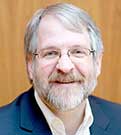|

 |
Ohio Department of Education
DeMaria named
Ohio’s 38th Superintendent of Public Instruction
6/27/2016
With the unanimous support of the State Board of Education, Paolo
DeMaria begins today as Ohio’s 38th superintendent of public
instruction.
“Education defines our future as individuals, as a community, as a
state and as a nation,” said Paolo DeMaria, superintendent of public
instruction. “It’s an exciting time for education in Ohio, and I look
forward to engaging with our families, teachers, administrators, policy
makers and advocates to help guide our work at the department.”
DeMaria returns to the Ohio Department of Education with nearly 30
years of experience in school finance and promoting higher student
achievement, college readiness and completion, and school choice for
families. He is an unabashed cheerleader for Ohio’s public schools,
having sent his own children to Columbus City Schools and The Graham
School.
At the department, he previously served as associate superintendent for
the Center for School Options and Finance, where he supervised the
distribution of more than $7 billion annually to Ohio’s K-12 school
districts and developed policies and legislative recommendations on
school finance and educational choices for families. All told, DeMaria
has a 25-year record of public service for the state of Ohio, having
formerly served as a staff member in the Ohio Senate, assistant
director and director of Ohio’s Office of Budget and Management and as
chief policy advisor to former Ohio Gov. Bob Taft.
DeMaria earned his bachelor of arts, summa cum laude, from Furman
University of Greenville, South Carolina, and a master’s of public
administration from The Ohio State University’s John Glenn College of
Public Affairs. He lives with his wife, Patty, and their cats in the
Schumacher Place neighborhood of Columbus, Ohio, and often bicycles to
work. The DeMarias have two grown children, Sara and Tristan.
The Ohio Department of Education oversees the state’s public education
system, which includes nearly 3,600 public schools and more than 1.6
million students. The department also monitors educational service
centers, other regional education providers, early learning and
childcare programs, and private schools.
|
|
|
|

